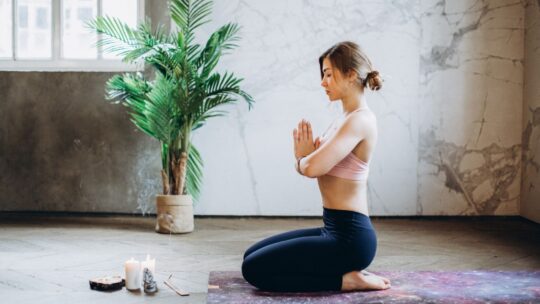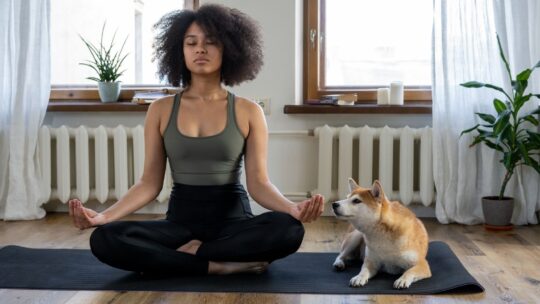
Suffering from anxiety and panic attacks can be difficult to navigate sometimes. No matter the severity or frequency of your anxiety attacks or panic attacks, being stuck in the feeling of nervousness, racing thoughts, and fear can take a serious toll on the health of your mind, body, and emotions.
While plenty of people will probably tell you that meditation, yoga, mindfulness, or other self-help practices will get rid of your problems, there’s much more to it than that.
Mindfulness meditation is all about being present in your current thoughts, feelings, and surroundings. It can help you clear your head of some of the racing thoughts and help you connect better to yourself and the sensations around you. While this isn’t a cure for anxiety — because anxiety isn’t as simple as curing things with one technique — it can be a great coping mechanism.
While many people say that they can’t meditate because of their anxiety, mindfulness meditation is a flexible practice that exists to help you find balance by working with your needs. There are a few key tips and techniques you can explore and keep in mind as you try out mindfulness meditation to help with anxiety and panic attacks. It’s all about figuring out which ones work for you.
Focus on the Breath
One of the easiest techniques you can use when you’re having an anxiety attack or panic attack — even if you’re not explicitly meditating — is to do breathing exercises. Simply counting the breaths, trying to even them out, or doing another favorite breathing exercise can help slow the physical anxiety responses as well as the mental ones.
This technique gives your whole system something to focus on. Whether you’re meditating, going about your day, or realizing you feel anxious, taking it back to the breath is always a great idea.
Check In With Your Body
Another great mindfulness meditation technique you can do anywhere to curb anxiety is a full-body scan or a body check-in. Simply scanning how your whole body feels from top to bottom — or the other way around — can help you find awareness of all the sensations in your body. It gives your mind something to focus on and reminds you to relax. This is an example of how mindfulness can help you connect to the body. Incorporating healing crystals into your yoga practice can help you to feel more connected to your body and promote a sense of well-being. For example, they can help to boost the energy of your meditation, improve your focus, and promote a sense of calm and relaxation. Each crystal has its own unique benefits, so it’s important to choose the right one for your needs. In particular, Black Tourmaline benefits are known for promoting balance and grounding. It helps to absorb negative energy and protect against electromagnetic fields. Other popular crystals for yoga include amethyst, rose quartz, and citrine.
Repeat Positive Affirmations

If you’re looking for a place where your mind can go, positive affirmations are a great idea. Anxiety attacks and panic attacks can often come with a swirl of thoughts, and replacing anxious thoughts with positive ones by telling yourself good things can help pull you out of that anxious spiral.
Phrases like, “this feeling will pass,” “I will be okay,” “I feel calm and relaxed,” or other affirmations more specific to your situation can be great places to start.
Use Grounding Techniques
Grounding techniques are a favorite of both the mindfulness and mental health world. While there are many grounding techniques you can choose from, such as using tuning forks for healing, the common thread of them all is their role in bringing you back to your surroundings and helping you focus on the immediate sensations of your body.
The five-four-three-two-one grounding technique is a great example of this, as it’s easy to remember, engages all your senses, and helps to relax you gradually.
Notice Your Passing Thoughts and Let Them Go
One of the biggest misconceptions about meditation is that the intention is to “clear your mind.” Most people who meditate will tell you that this isn’t the goal at all. Instead, it’s about calming and allowing your thoughts to pass slowly. This means that, rather than trying to banish your anxious thoughts in meditation, the goal is simply to acknowledge them and let them go.
Understand that your anxious thoughts don’t make you bad at meditation, and they don’t mean you’re doing it wrong. Simply notice them and allow them to pass from your mind, and you’ll be well on your way.
Find Mindful Activities
Another technique you can try in order to use mindfulness in a way that works for you is to find activities that embody mindfulness and help you engage with your surroundings in a conscious way. You may not be up to the challenge of sitting still yet, and that’s okay. Really, you can make anything mindful.
Try focusing on the sensations of the outdoors during walking meditation, making tea and drinking it without distraction, mindfully eating a meal, or engaging in a workout or yoga practice.
Use Tools That Work for You

If you think you need a little bit of guidance and direction, lean into that instinct. Anxiety can make it difficult to focus and hold to the exercises you set out for yourself. Finding apps, videos, and guided courses to help you can allow you to focus completely on what you’re hearing and let that lead the way.
Finding Your Mindful Niche
Mindfulness and meditation are practices that work with you to meet you wherever you are in your journey. While meditating can’t cure anxiety and get rid of all panic attacks forever, it can help you cope, ground yourself and find a bit more relaxation in your life as time goes on.























